Growing up, I spent many summer afternoons along the banks of a local canal snatching painted turtles as they basked on fallen logs. For many of us, turtles are the gateway animals that start a lifelong fascination with nature. They provide us our first chance to hold and closely examine a wild animal. I still have a special fondness for turtles as a result of those experiences.
Turtles have been around for 200 million years and are found on every continent except Antarctica. Given this, it’s surprising to learn that there are only 320 turtle species worldwide. In comparison, there are over 3,000 species of snakes and more than 10,000 species of birds. And according to the International Union for the Conservation of Nature (IUCN), more than half of the world’s turtle species are currently vulnerable to extinction.
In my home state of New Hampshire, painted, snapping, and musk turtles are quite common, while Blanding’s, box, spotted, and wood turtles are far less abundant. It’s the scarcity of wood turtles that’s especially concerning because they were once quite common in much of New England. Early naturalists, including Thoreau, wrote of frequent encounters with wood turtles while walking along rivers and streams. More recent reports indicate that they remained common at least until the 1960s. The subsequent decline of wood turtles has occurred throughout their range, which includes the northeastern United States and neighboring Canadian provinces. In 2012, increasing concern over the scarcity of wood turtles resulted in a petition to the US Fish and Wildlife Service to list them as a threatened or endangered species. That hasn’t happened – not yet, at least.
Given my interest in turtles, I set out to understand the reasons for the decline of wood turtles. To do this, I connected with a group of wildlife biologists and university researchers who are identifying the causes of the decline and trying to find ways to reverse it.
Why are wood turtles disappearing?
Although their name suggests a life lived on land, wood turtles spend much of their lives unseen in streams and rivers. So getting to know and understand them requires patience and skill – and some technology. Mike Marchand and Joshua Megyesy of the New Hampshire Fish and Game Department devote their summers to searching out suitable habitats and then radio-tagging and following turtles. According to Marchand and Megyesy, wood turtles prefer gently flowing rivers and streams with rocky or gravel bottoms and clear water. As development has increased in many rural communities in New Hampshire in recent decades, streamside habitats have been lost as land has been cleared for building lots and roads. Marchand and Megyesy suspect these changes have had a negative effect on both upland forests and stream water quality. Habitat loss and degradation have affected many species, but for wood turtles, those changes have often gone unnoticed.
When considering the causes of decline in a given animal population, knowing that animal’s life history is essential. Adult wood turtles have few enemies and can live for 50 years or more in the wild. But like many rare or endangered species, wood turtles are slow to reproduce. Sexual maturity of both males and females coincides with their reaching a large body size, usually when they are about 14 to 18 years old. By contrast, painted turtles in New England breed when they are six years old or younger. In late May or June, female wood turtles that have mated earlier in the spring or the previous fall head out in search of a sandy, sunlit site where they will lay about 10 eggs. For some, this is a short walk to a streamside beach. But for others, finding suitable nesting habitat may require traveling as far as two miles from their home stream. Turtles moving such long distances overland are especially vulnerable. Although their shells may protect them from a curious fox or coyote, they are no match for farm machinery as they move through fields or for cars and trucks when they cross roads.
Considering how long it takes for wood turtles to reach maturity, any additional mortality among adults has a serious effect on the overall population. Brad Compton, while at the University of Maine, used a simple population model to investigate the effects of adult mortality. Using 100 turtles as a baseline and factoring in estimates of natural mortality, Compton calculated that this theoretical population would go extinct in about 75 years if only two additional adult turtles were killed or removed each year. If mortalities or removals increased to three adults per year, extinction would occur in 50 years. From those estimates, it’s clear that populations of wood turtles in areas with substantial human activity are in jeopardy.
The threat to wood turtles from development extends beyond roadkill. When an area is developed, the resulting habitat is a boon for raccoons, skunks, and crows, which are all turtle nest predators. In nests that survive predation, hatching usually occurs from late August to early October, depending on soil temperature. Emerging turtles are about the size of a flattened Ping-Pong ball and weigh less than half an ounce, making their prospects for survival tenuous.
Barry Wicklow, a professor of biology at Saint Anselm’s College, has been studying young wood turtles in central New Hampshire since the 1990s. Among the topics Wicklow has explored is what happens to hatchlings after they leave the nest. Here again, the distance of a nest from a stream affects hatchling survival because it can take more than a week for a hatchling to reach the relative safety of water. Among the unexpected predators of hatchlings Wicklow has identified are chipmunks. In Ontario, Canada, shrews have been identified as major predators of hatchlings. In Wicklow’s study, only 11 percent of radio-tagged youngsters survived to mid-October, when the hatchings enter winter dormancy.
Everyone Loves Turtles – Maybe Too Much
Wood turtles are handsome reptiles – at least to those of us who admire turtles – so it isn’t surprising that they are often sought out as pets. But such appreciation can have unwanted consequences. To gain some perspective on the demand for pet wood turtles and how that market might affect conservation efforts, Michael Jones, currently a herpetologist with the Massachusetts Division of Fisheries and Wildlife, and Lisabeth Willey of Antioch University New England, examined the trend in commercial prices for wood turtles. Using a standardized dollar value, they found that prices for an adult turtle ranged from about 20 dollars in the early 1960s to nearly 400 dollars in 2014. Such a rise in prices suggests that either demand has increased or wood turtles have become scarce – or perhaps it’s both.
One unsettling glimpse at how humans can disrupt an ecosystem is provided by Steven Garber and Joanna Burger in work done at Rutgers University. For 20 years, the researchers monitored two populations of wood turtles in a municipal watershed in southeastern Connecticut. For the first 10 years of their project, there was no public access to the area, and both turtle populations slowly increased, stabilizing at about 50 turtles each. After 10 years, public access for hiking and fishing was permitted, and both turtle populations began a steep decline. Within 10 years, wood turtles were gone from the area. Throughout their study, the size of the forest remained the same, road construction was restricted, and water quality was constant. The only thing that changed was the opening of the watershed to public recreation. Garber and Burger speculated that either people took turtles home as pets, or the presence of humans brought about the increased predation. The presence of raccoons and crows, for example, could have increased in response to trash or dead fish left by hikers and anglers. In either case, human access to the area caused the turtle population to collapse. Similar rapid declines have been observed in other wood turtle populations.
Although it seems harmless, taking a turtle home as a pet may have real consequences even if that turtle is eventually returned to the wild. Several years ago, one of the radio-tagged turtles monitored by Barry Wicklow went missing. It eventually turned up 12 miles from its usual haunts. Wicklow speculated that the turtle was picked up and brought home by a turtle aficionado. Perhaps feeling guilty – or realizing that the radio transmitter couldn’t be easily removed – the new pet owner eventually turned it loose. For a turtle, being moved 12 miles is like being moved to another state or country. Displaced turtles may not find food, and they certainly have difficulty locating a mate or a suitable winter den site. Recall Brad Compton’s population model, which indicated that removing only a few adult turtles can decimate a population. Fortunately, taking wood turtles from the wild is now against the law in nearly all the states where they are found.
A more sinister consequence of our desire to have pet turtles is the likelihood that poachers are illegally cashing in on the demand. Several years ago, a turtle poacher was caught in Virginia with 80 wood turtles that were taken in Maine and destined for the pet market. Demand for wood turtles and other reptiles is great, and it extends internationally. Prices for adult wood turtles in Southeast Asia, for example, have exceeded hundreds of dollars, and wood turtles have been confiscated at international airports during their shipment to foreign markets. A skilled poacher can identify suitable wood turtle habitat and, in a relatively short time, locate and remove a large percentage of the local population – sending it on a path to extinction.
Fortunately, law enforcement has gotten serious about prosecuting such poachers. In a sting operation, federal officers recently captured a known turtle poacher attempting to purchase 100 wild-caught wood turtles. He was subsequently fined some $40,000 and sentenced to more than three years in prison.
Turtle biologists are so concerned that poachers may find their study animals that they no longer report specific details on the locations of their studies. This is something to keep in mind if you find a wood turtle: if you post a picture on social media, be sure to remove the geographic information attached to it. That information is now automatically recorded by some digital cameras and most smartphones. By posting your turtle photo along with location information, you might be leading a poacher right to the turtle.
Finding Solutions
Last fall, I attended a conference that brought together about 100 turtle biologists to summarize their efforts to understand wood turtles. Participants included biologists from most US states and Canadian provinces within the range of the wood turtle, and their common goal was to ensure that wood turtles not only survive, but thrive. Some of their success stories were encouraging. For example, Kurt Buhlmann (Savannah River Ecology Laboratory, University of Georgia) and Colin Osborn (US Fish and Wildlife Service) studied a small population of wood turtles at the Great Swamp National Wildlife Refuge in New Jersey and found that it was comprised entirely of adults. That suggested consistent nest failure or a high mortality of juveniles. To change this, Buhlmann and Osborn used a multifaceted approach: first, they created protected nesting habitat – essentially a large mound of sand that was fenced so that turtles could crawl in, but raccoons and other nest predators would be kept out. Then, any turtle nests they found outside of the fenced mound were covered with hardware cloth. Finally, the researchers released the turtles once they hatched. Both methods worked, and nest success increased substantially.
Suspecting that hatchling survival might also be low, Buhlmann and Osborn sought out the help of Brian Bastarache at the Bristol County Agricultural High School in Massachusetts. Bastarache and his students responded by converting a school greenhouse into an impressive facility where hatchling turtles are given a “head start” toward adulthood. Basically, hatchling turtles are brought to the facility and provided with ideal conditions for early growth. Instead of hibernating during their first winter, turtles in the greenhouse have summer-like conditions year-round and are provided with an ample food supply. Bastarache’s students took on the role of caregivers and monitored the progress of New Jersey hatchlings until they were returned to the wild the following spring. The results of this program have been impressive. After nine months in the Bristol facility, hatchlings have grown to the size of four- to five-year-old turtles raised in the wild. Although there were some concerns that the captive-raised hatchlings would be “less wild” and therefore have difficulty once released, subsequent monitoring has revealed that juveniles from the head-start program have higher survival rates than those from the wild. Simply put, bigger turtles have fewer enemies. Also, bigger turtles from the head-start program will likely reproduce several years before wild hatchlings of the same age – an extra benefit to population restoration.
In addition to restoring turtle populations, conservationists are now focusing on maintaining and improving stream and river habitats for turtles. State biologists throughout the Northeast have identified the best areas for wood turtles and are currently monitoring turtle numbers in those areas. That initiative is being supported by the Natural Resource Conservation Service (NRCS), a federal organization that assists private landowners who are interested in helping wildlife. NRCS has expanded its “Working Lands for Wildlife” program to include the purchase of conservation easements designed to protect important turtle habitats and to fund improvements to habitats that have been degraded. Recently, NRCS State Resource Conservationist Don Keirstead and consulting geomorphologist John Field teamed up with Marchand and Megyesy of New Hampshire Fish and Game to enhance a section of river where eroded banks were threatening fields and degrading conditions for local wood turtles. By constructing a series of log revetments that resemble the branch-and-root tangles of trees and shrubs that grow along the shoreline, the group was able to improve conditions for the landowner and provide winter den sites for the turtles. Thanks to projects like these, life is getting better for wood turtles.
Although my focus has been on the plight of wood turtles, it is important to mention that other turtles in the region are also facing the challenges of long-term survival. Habitat loss, elevated predation, and an illegal pet trade have reduced populations of Blanding’s, box, and spotted turtles. Protection and habitat restoration are benefitting these turtles as well. Hopefully, this will mean that children can continue to have the thrill of discovery when they encounter a turtle for the first time.


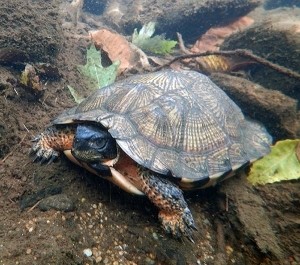
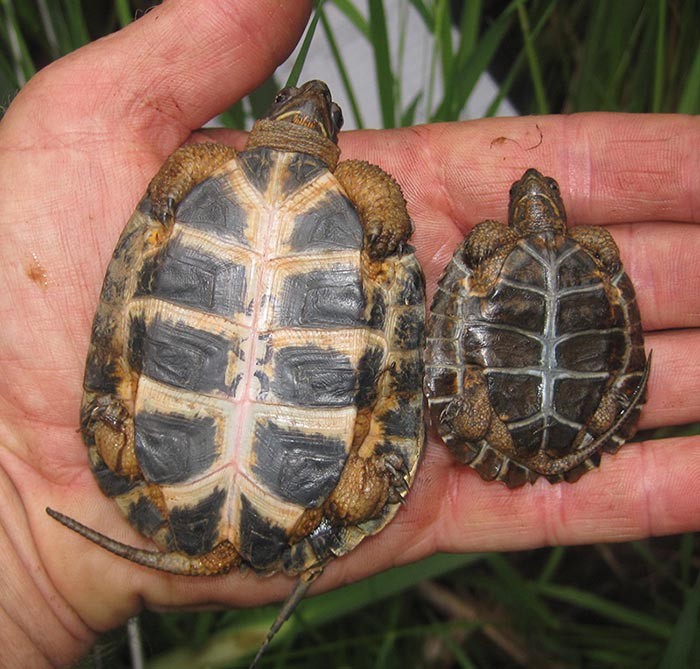

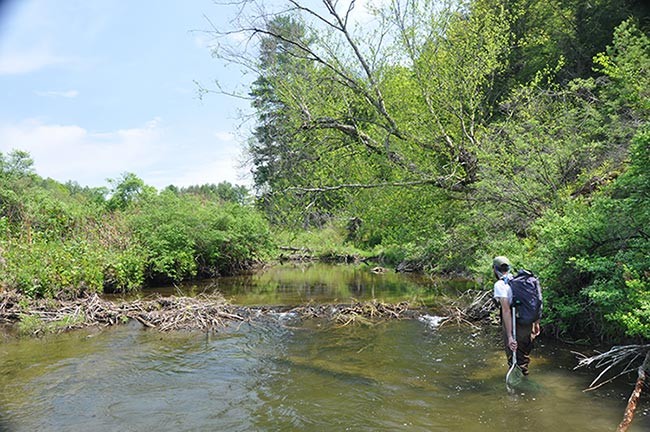
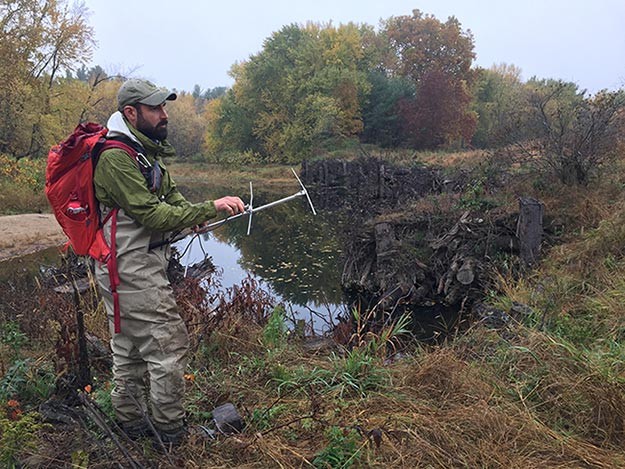

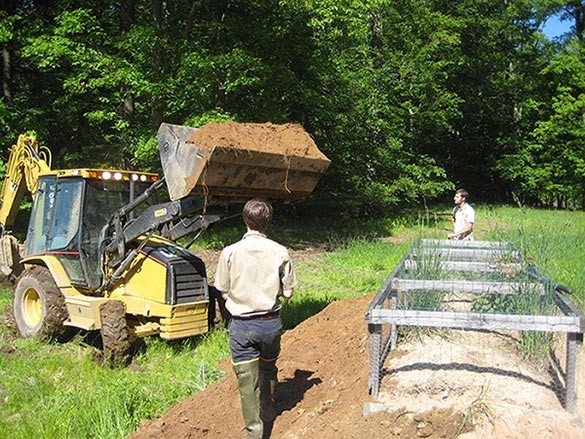
Discussion *